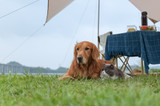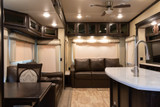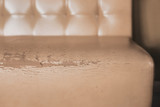The Importance of a Good Shower Head
RV showers aren’t generally regarded as an exceptionally luxurious experience due to space restrictions, limited water availability, and low water heating capacity, but when you are out camping in the woods, the presence of a shower is one of the most incredible amenities afforded by an RV. That’s not to say, though, that most RV showers wouldn’t benefit from a bit of an upgrade.
Many people choose to replace the shower head in their RV for a variety of reasons. Often, the shower faucets and heads that come installed in RVs are pretty basic and not very efficient when it comes to water use. There are, however, plenty of after-market options that are easy-to-install, more efficient, and have multiple unique spray options. The best shower head and faucet combo will vary depending on various factors, including your personal preferences. This article will discuss some of the primary considerations for replacing an RV shower faucet and head and tips for showering in your RV when water is limited.
Replacing Your Shower Head & Faucet
Individual preferences vary regarding the features of an RV shower head and faucet. Things like how often you will be using the shower, what type of water source you will typically be using, and the amount of available space will all come into play when deciding to upgrade your RV’s shower set-up.
Features
In order to compare different shower faucets and shower heads, it is crucial to understand the general product features and what specific types are available.
Flow Rate (GPM)
The flow rate of water is measured in gallons per minute. This measurement is commonly used when discussing plumbing fixtures, such as faucets and shower heads. A lower flow rate is more efficient since less water flows through the fixture. In 1992, the federal government mandated a maximum flow rate of 2.5 GPM for new fixtures. Typically, a GPM of 1.8 or lower is considered low-flow. Flow rate can impact water pressure, but it is not the most important determining factor. When looking for a shower head and faucet to install into your RV, it’s better to stick with low flow rate options.
Spray Options
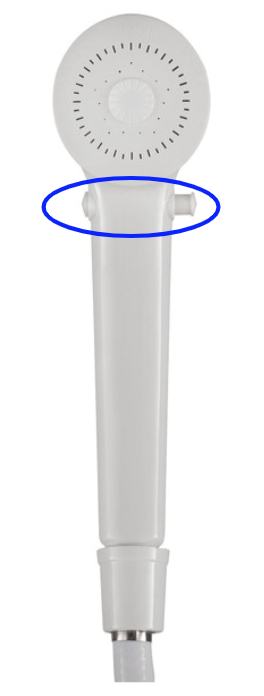
Many shower heads feature an adjustable sprayer that allows users to choose the pressure level or spray pattern. The simple adjustable shower heads may only have 2 options - full for lower pressure, wide coverage spray, or stream for a more concentrated spray with greater force. The more intricate shower heads will feature more spray patterns and combination options.
Shut-Off Valve
A shut-off valve allows you to control the water flow from the shower head without turning off the water flow to the faucet. This is extremely useful in RVs when the water supply is limited because you can stop the water without affecting the current temperature. Some shower heads will have a shut-off valve built into the fixture (see picture to right), while some shut-off valves are closer to the water source and may not be accessible from inside the shower.
Fixed or Detachable Head
A fixed shower head is directly attached to the wall, while a handheld shower head is connected to the shower arm by a hose and secured to a temporary mount so that the head can be detached and used more freely. Fixed shower heads may be minimally adjusted, with often only the tilt angle of the head being free to move.
The shower set-up that the manufacturer installs is typically a fixed shower head. Handheld shower heads are, on average, more efficient than fixed shower heads and allow you to direct the water spray for easier washing. You can also use the detachable shower head to clean the shower and tub as well. Despite these benefits, some people still choose a fixed head over a handheld because they prefer the overhead spray.
Water Pressure
Water pressure is a feature of your RV’s plumbing system rather than a feature of the shower head. Typically, RV water systems are set to operate around 40-50 PSI, whereas residential home water systems operate around 60 PSI. Water pressure is adjustable to an extent, but you have to be careful not to set the water pressure too high, or you could risk damaging the system in the form of a burst pipe or connection. When water pressure is too low, however, it can be difficult to rinse clean in the shower. If you have water pressure issues throughout your RV, you should get the system checked out before replacing your shower head or faucet.
Material
Shower heads can be made from a variety of materials, such as brass, stainless steel, or ABS plastic. Metal is a durable, long-lasting material when well-taken care of but is susceptible to corrosion and rust. ABS plastic is a safe alternative to metal materials and won’t rust. Many shower heads may feature both metal and plastic materials to achieve the look of a metal faucet with the corrosion-resistant features of plastic.
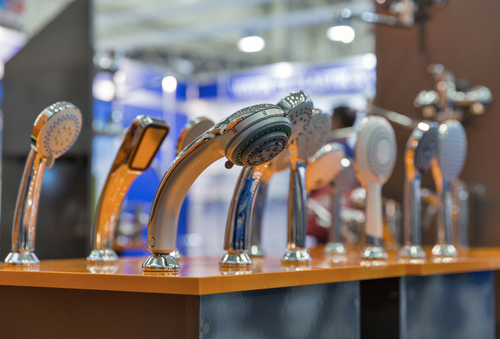
RV Shower Tips
Once you’ve been showering in an RV for a while, you get a routine down to use as little water as possible while still getting clean. But the first couple of times, you may run out of hot water before you get a chance to rinse or blow through your water supply more quickly than anticipated. Keep reading for some tips on how to conserve water during your RV showers!
Utilize the shut-off valve during showers.
The shut-off valve in an RV shower can be handy for saving water and allows you to maintain a steady water temperature while doing so. Instead of turning off the water entirely during the lather-up phase and then having to turn it back on and readjust the temperature, a shut-off valve allows you to pause the water flow momentarily and then resume when ready as if nothing happened. When every gallon counts, as it does in an RV, a shut-off valve can give you more control over your water use.
Collect the run-up cold water.
Most people would rather not be subject to an ice-cold shower, but when water is limited, and the water heating process takes time, it can feel wasteful to let the water run until it reaches the correct temperature. Instead of letting this water run down the drain, try collecting the run-up cold water for use in other areas of your RV. One of the most common things to do with this collected water is to use it for flushing the toilet. This way, the cold run-up water doesn’t go to waste, and toilets will be pulling less additional water.
Install a more efficient faucet.
We discussed the GPM measurement earlier and how it relates to efficiency. If you have a high to medium flow faucet and shower head, replacing them with low-flow options of 1.8 GPM or lower is the most direct way to reduce water usage in the shower. If you already use a low-flow faucet and head, ensure it is clean and functioning correctly.
Keep your shower head clean.
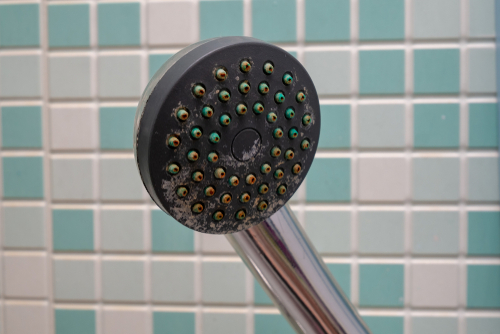
Shower heads can be clogged with build-up if not cleaned regularly. This build-up can then affect the water flow and pressure coming from the head. You can see what a clogged shower head looks like in the picture to the right. Simply soaking the shower head in a bag of white vinegar effectively removes residue without damaging the sprayer seals.
space
Are you team fixed shower head or team detachable? Let's hear it in the comments below.
Recent Posts
-
How to Keep Your Pets Safe While Camping
RVing and camping are a great getaway from the hustle and bustle of work and the city and the day-to …Jul 2nd 2024 -
Why Replace Your RV Furniture?
You may wonder when is the best time to replace your RV furniture. There is no one right answer to t …May 20th 2024 -
Can You Put Regular Furniture in an RV?
Many new and old RV owners ask themselves this question when they feel the need to update th …Apr 25th 2024 -
4 Tips for Securing RV Furniture While Traveling | RecPro
How To Secure RV Furniture There are few things that beat going out on an adventure with an RV …Apr 25th 2024 -
How To Keep RV Furniture From Peeling
Peeling RV Furniture | Why it Peels and How to Stop it Your RV furniture is a point of pride on yo …Apr 25th 2024 -
Turning up the Heat With an RV Fireplace
There’s an unlimited number of cool and exciting features you could add to your recreational vehicle …Apr 25th 2024


